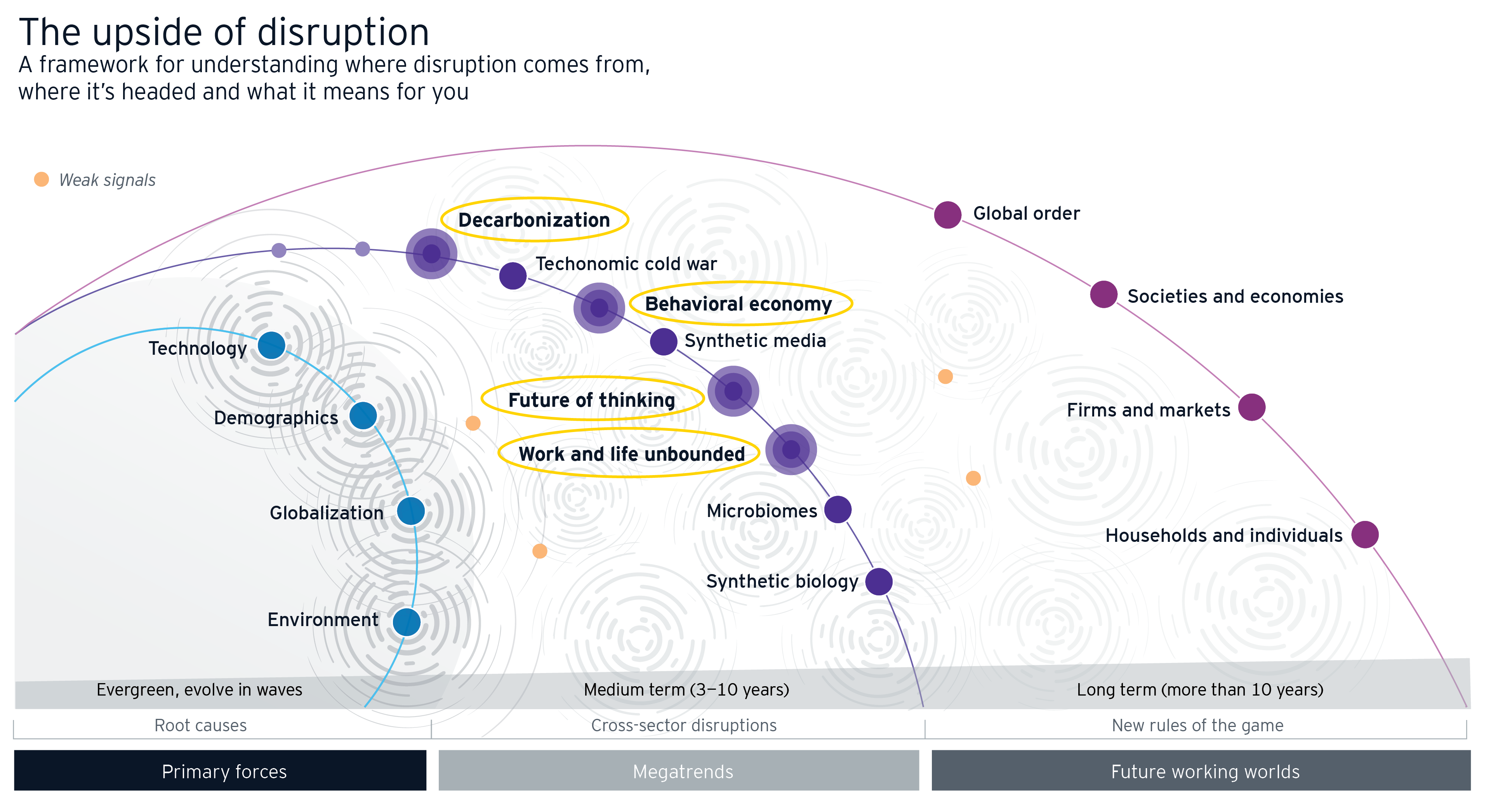While management contend with resiliency throughout this critical time, boards need to adopt a “futurist” mindset in order to ensure organizational sustainability in the long-term.
The report focuses on eight megatrends created by four primary forces: technological innovation, globalization, demographic shifts and environmental change.
Of the eight megatrends (decarbonization, techonomic cold war, behavioral economy, synthetic media, future of thinking, work and life unbounded, microbiomes and synthetic biology), the EY Global Center for Board Matters has identified four that have the most impact and applicability across boardrooms in every industry, geography or governance model. These are:
- Decarbonization
- Behavioral economy
- Future of thinking
- Work and life unbounded
We have set out the implications of each megatrend for boards and then offered recommendations on what they can do to respond.

1. Decarbonization
Dissatisfaction with government progress on climate action has been growing for some time, and society is increasingly looking to businesses to bridge the gap. The 2019 CEO Imperative Study reveals that both investors and boards expect CEOs to respond to humanity’s greatest challenges, including climate change, with many investors now raising the stakes vis-à-vis the proactive pursuit of ethical investments.
This means boards must continue to champion climate-related considerations with their management teams to ensure they are factored into their ongoing decision-making processes. Doing so, if truly authentic, will not only position the organization as a favorable investment proposition but equally ensure they attract the talent they need for long-term growth. Generation Z’s expectation is that organizations and brands will go beyond marketing to truly measurable differences. And as Generation Z matures, organizations will be expected to not only be climate-neutral but also to make a net positive contribution.
As such, boards have a critical role to play in demanding more frequent and in-depth reporting metrics on social and environmental performance. There is no question that investors are increasingly analyzing and comparing organizations for capital allocation trade-offs as stakeholders hold them to account. With executive and board remuneration and incentive packages under review, it is likely that we will see a heightened interest in this area from a strategic standpoint and underpinned by evolving policy decisions.
Related article
2. Behavioral economy
Human behavior is becoming a commodity — quantified, standardized, packaged and traded, as much as consumer data is today. This commoditization, combined with the maturing of disciplines such as behavioral economics and affective computing, may enable organizations to influence and shape consumer behavior as never before.
Consumer preferences
62%Percentage of consumers in our Future Consumer Index that are more likely to purchase from companies that are doing good for society.
While behavioral economics applies insights from psychology on the decision-making of individuals, affective computing, also known as emotion AI, brings machines into the realm of human emotion.
Consequently, organizations must use behavioral economics and affective computing to measure, understand and shape behavior, while being transparent with their consumers.
In parallel to understanding customer’s preferences, organizations must also consider what kind of consumer is emerging and what new customer segments are being created. The EY Future Consumer Index, published in April 2020, found that 62% of respondents are more likely to purchase from companies that are doing good for society. This means that organizations need to be on their A-game at all times. Better transparency, not secrecy or defensiveness, is key. And those that do it well will have a sizable competitive advantage.
3. Future of thinking
There is no question that technology is profoundly changing how we think and act: from social media and smartphones to “intelligent technologies” like robotic process automation and AI. And at work, it permeates just about everything we do.
As such it is critical that organizations strike the right balance of adopting and deploying digital technologies that liberate staff for higher-value activities while at the same time preserving human centricity.
Technology is also creating new challenges with respect to trust. In an era of synthetic media technologies such as “deepfakes,” how will organizations ensure that the information and technologies they deploy are trusted? And how can they ensure they are protecting against and mitigating cyber risks including disinformation, phishing and malware? Failure to do so comes at a high cost, both financially and reputationally, and few organizations these days can afford any avoidable missteps. This is why it cannot be the sole responsibility of the technology office but rather should be embedded into risk management processes aligned to company culture.
4. Work and life unbounded
The boundaries that define work, leisure and learning are blurring more than ever before.
For employers, this presents both huge opportunities and significant challenges. On one hand, they have an unprecedented opportunity to increase job satisfaction and productivity. On the other, they need to rethink the work environment, along with the way they approach their best asset: people.
However, the EY global board risk survey conducted in late 2019 showed that board directors ranked people issues as only the seventh-most important risk in the short term. Boards should re-prioritize the importance of talent and workforce issues by viewing them not simply as the domain of management but instead contextualize within their broader organizational purpose.
What are the next steps for boards?
By adopting a futurist mindset and by viewing their organizations through the lens of these megatrends, boards will be better equipped to work with their management teams to take informed and decisive actions for long-term success.
We suggest board members carefully digest each megatrend and consider the potential impacts and implications not just as single issues but rather as interdependent forces to be built into the organization’s strategic frameworks. More importantly, we recommend that boards and management teams develop scenarios containing these trends and identify the associated areas of risk and spaces of possibility. Scenario development is an often discussed but seldom utilized tool for board and executive teams to stress-test their thinking; when properly done, it provides a foundation for exploiting upside and better anticipating downside.
Finally, forward-looking boards are already exploring new value drivers, however many of the societal impacts the pandemic has triggered are still to occur. As such, it is critical that the entire board, driven by the chair, continues to lead and “listen and learn, not simply teach and tell.”
Summary
The role of the board is fully in focus as society shifts in a post-pandemic world. The EY Megatrends can help boards to adopt a “futurist” mindset in order to ensure organizational sustainability in the long term.


